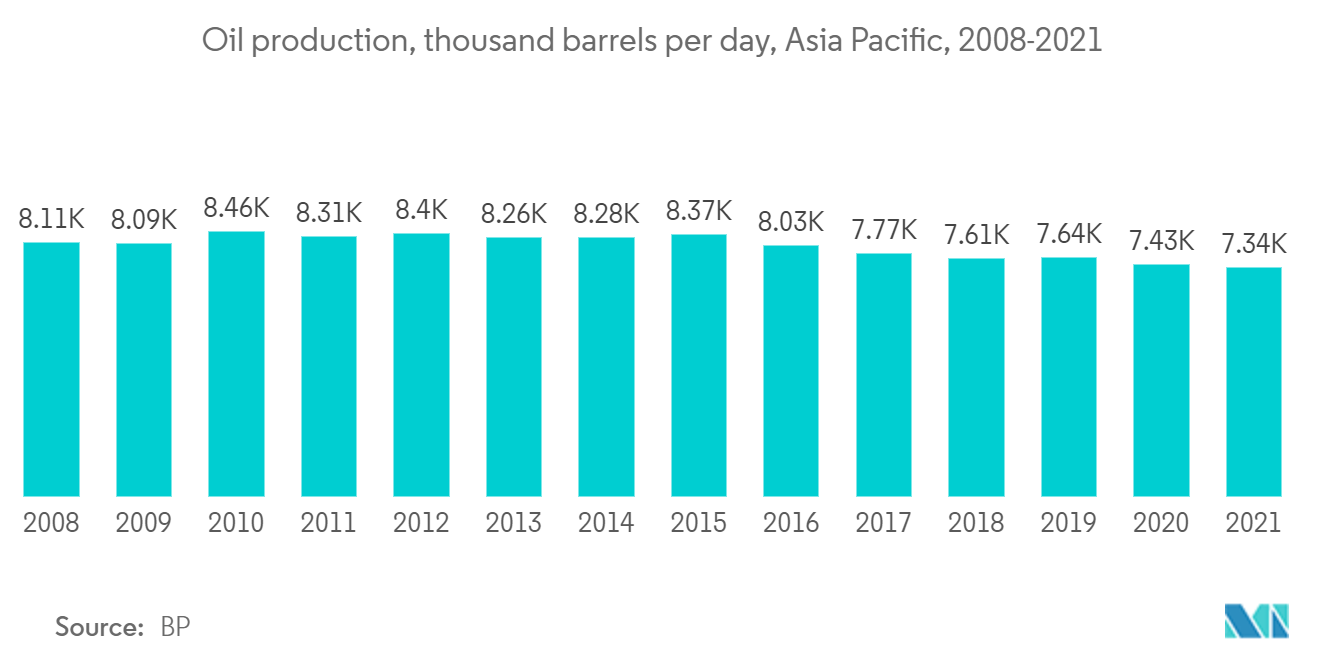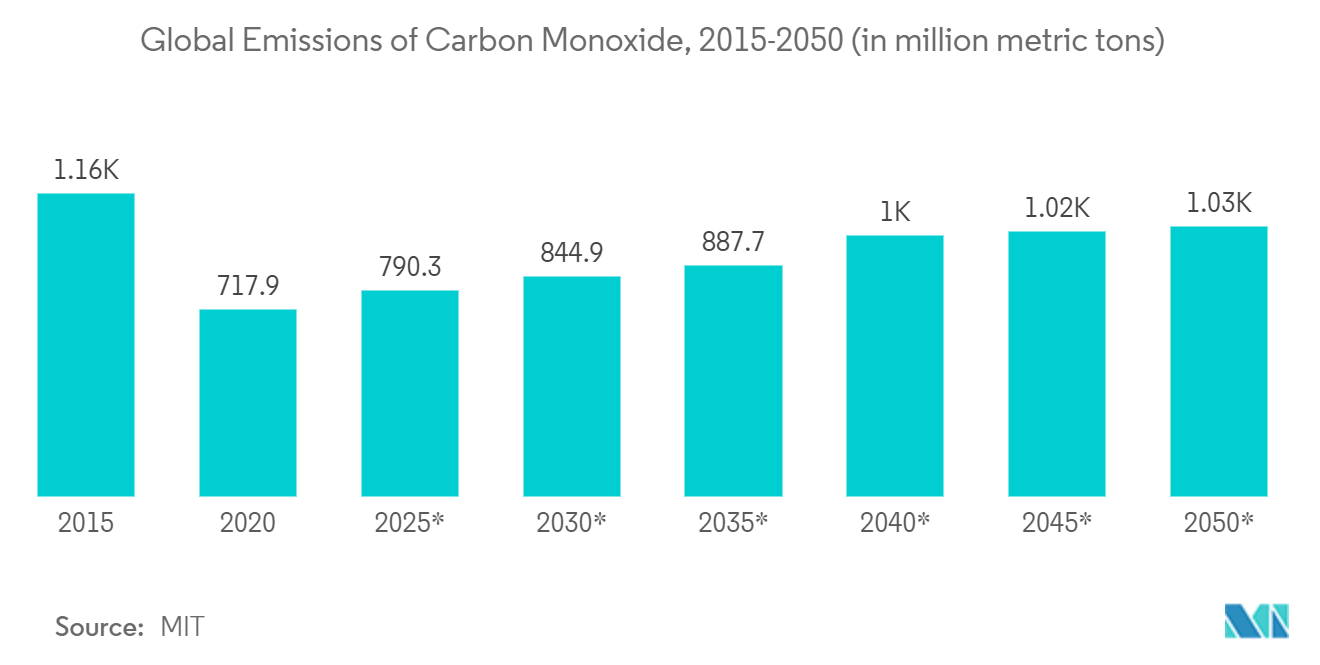Market Trends of Asia Pacific Gas Detector Industry
This section covers the major market trends shaping the APAC Gas Detector Market according to our research experts:
Oil & Gas to Register Significant Growth
- The oil and gas market is the fastest in the region due to government initiatives encouraging the use of gas detectors. With the growing energy demand, the region is facing more significant challenges in securing the supply of energy resources to meet the domestic requirements of each economy.
- The Asia Pacific gas detectors market in the oil and gas sector is expected to grow in the future, owing to the enormous rise in demand for plant safety. The growing demand for gas monitoring amenities to detect the presence of harmful gases is expected to drive constant gas detector market growth, particularly in the industrial segment.
- The deployment of IoT in the oil and gas industry has realized superior field communication, real-time monitoring, digital oil field infrastructure, condensed cost of maintenance, reduced power consumption, higher productivity, and, thus, heightened safety and security of assets and workforce. For instance, gas wastage is a crucial issue that needs to be countered. LPG gas is highly flammable and can inflict harm to life and property. Gas detectors, coupled with IoT, can play a substantial role in gas detection and block the wastage of gases, thus fueling the market's growth.
- Furthermore, the businesses in the region are focusing on incorporating advanced technologies for proposing gas detecting product differentiation in the market. For instance, Huawei eLTE Gas Detection Solution provides efficient performance for IoT scenarios, requiring fewer devices, with correspondingly fewer management and maintenance efforts.
- Moreover, global energy needs are anticipated to increase by around 40% between 2013 and 2030, particularly in developing nations like India and China. The IEA (International Energy Agency) reported that the demand for oil and gas is projected to increase by 50% and 20% in those countries, respectively. Moreover, the discovery of oil reserves in countries like India and China (the Arabian Sea and Juggar Basin, respectively) and upcoming investments in exploration processes are expected to drive the need for gas detectors.
- Further, several initiatives are being implemented in the region to ensure safety. The APEC Oil and Gas Security Initiative (OGSI) was established to assist economies in tackling the issue of energy supply security and how to deal with potential supply shortages and emergencies. It has three critical pillars - Oil and Gas Security Exercise (OGSE), Oil and Gas Security Studies (OGSS), and Oil and Gas Security Network (OGSN). Thus, gas detectors are of paramount importance in these areas.
- Additionally, several regional projects are underway, which would increase the demand for gas detectors. Some of these include Sriracha Refinery Expansion & Upgrade (To be started in 2024 in Thailand), Pulau Muara Besar Refinery & Petrochemical Complex Phase 2 (To be started in 2022 in China), etc.

Fixed Gas Detectors to Hold Significant Market Share
- Fixed gas detectors are installed when there is a need for round-the-clock monitoring. They are designed to alert workers of the potential danger of toxic gas exposure, asphyxiation due to lack of oxygen, or explosion caused by combustible gases. These gas detectors are used in an enclosed or partially enclosed space where hazardous gases accumulate.
- Toxic gas detectors are widely used by industries including gas and oil, mining, nuclear, medical, food and beverage, construction, and industrial. A metal oxide-based gas sensor is one of the most commonly used detectors for detecting toxic gases. These sensors increase their electrical resistance by contacting gasses such as carbon monoxide, hydrogen, methane, and butane. Most home-based smoke detection systems are oxide-based sensors.
- Combustible gas detectors by Fixed type hold a significant share in the gas detectors market. These sensors detect and respond to combustible gases or vapors and are primarily used in industrial plants to detect gas leakage or buildup before it can reach an explosive level.
- These detectors measure the concentration of certain gases in a specified area through sensors such as infrared, electrochemical, ultrasonic, or semiconductor and compare that to a reference point or scale. If a sensor's response surpasses the pre-set level, an alarm, light, or combination of signals warns the user.
- Additionally, companies continuously invest in product innovation by incorporating advanced technologies in fixed gas detectors. These detectors are now being developed to monitor multiple gases. For instance, Teledyne's OLC 10 and OLCT 10 gas sensors are designed to detect combustible or toxic gases for tertiary applications (boiler plants, battery charging rooms, car parks, and hospitals). Two OLC 10's can be connected to one detection channel to monitor the same area without an additional junction box or wiring.
- For instance, in July 2021, ION Science launched Cub 11.7 eV personal device. This toxic gas detection solution operates in temperatures between 0 °C to 55 °C and is resistant to the effects of humidity or moisture. This gas detector weighs in at a mere 111 grams, so it is comfortable to wear; its compact size enables workers to move around unfettered by cumbersome equipment and has a battery life of up to 12 hours.
- Moreover, The presence of many industries in the APAC region is a crucial market wherein the demand for these detectors is increasing. The rising demand and stable profitability are attracting several vendors to enter the market. For instance, in February 2021, NevadaNano Inc., a gas detection sensor technology vendor, announced that Elematec Corporation would distribute its Molecular Property Spectrometer to its customer base throughout Japan.
- Furthermore, these detectors are also used in the oil & gas industry. Natural gas and crude oil are located deep underground, concealed in rock layers, are difficult to access, and are found in places with extreme climates. Thus, advancements in sensor capability coupled with increasing computing power are driving the demand for these detectors.


